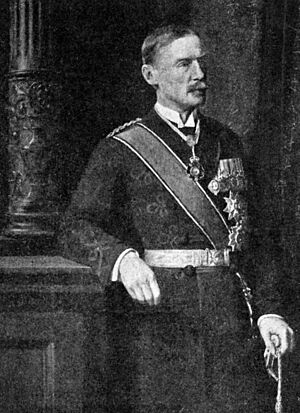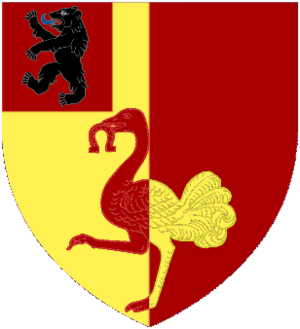Henry McMahon facts for kids
Quick facts for kids
Henry McMahon
|
|
|---|---|

Painting of Henry McMahon by John Collier, c. 1915
|
|
| Personal details | |
| Born | 28 November 1862 Simla, Punjab Province, British India |
| Died | 29 December 1949 (aged 87) London, United Kingdom |
| Occupation | Diplomat, commissioner |
| Known for | McMahon-Hussein Correspondence, the McMahon Line, Declaration to the Seven |
Sir Vincent Arthur Henry McMahon (28 November 1862 – 29 December 1949) was a British officer and diplomat. He worked for the British government in India and later in Egypt.
From 1911 to 1915, McMahon was the Foreign Secretary for the Government of India. In this role, he helped negotiate an important agreement about Tibet. Later, from 1915 to 1917, he was the High Commissioner in Egypt. This meant he was Britain's top representative there. He is well-known for his letters with Hussein bin Ali, the leader of Mecca, which promised Arab independence. He also played a part in the "Declaration to the Seven."
Contents
Early Life and Education
Henry McMahon was born in Simla, British India, in 1862. His father, Charles Alexander McMahon, was a geologist and a commissioner in India. His family had a history of working for the East India Company.
McMahon went to school in England at Haileybury College. After that, he attended the Royal Military College, Sandhurst. This is where he trained to become an army officer.
Career in British India
McMahon began his military career in 1883 as a lieutenant. He joined the Indian Staff Corps in 1885. This was a special part of the British Army in India.
He then moved into the civil service in Punjab in 1887. By 1890, he was part of the Indian Political Department. He worked in many different areas, including Balochistan and Gilgit. He became known for his skills in dealing with local leaders. He was promoted to captain in 1894 and major in 1901.
McMahon was good at languages. He learned Persian, Pashto, Hindustani, and Arabic. These skills were very helpful in his diplomatic work.
In 1911, McMahon became the Foreign Secretary for the Government of India. He held this important job until 1915.
The Simla Convention
From 1913 to 1914, McMahon led important talks. These talks were about the borders and relationship between Tibet, China, and Britain. The meeting was called the Simla Conference.
Even though China did not sign the final agreement, Tibet and Britain did. This agreement guided how Britain dealt with Tibet until 1947. During these talks, a border was also agreed upon in northeast India. This border is still known as the McMahon Line.
Work in the Middle East
In 1915, McMahon was sent to Egypt. He became the High Commissioner there. This was a very important diplomatic role.
McMahon-Hussein Correspondence
McMahon started writing letters to Hussein bin Ali. Hussein was the leader of Mecca and the Hijaz region. Britain wanted Hussein to help them fight against the Ottoman Empire during World War I.
In these letters, McMahon promised Hussein that Arab lands would become independent. This was in exchange for Arab support against the Ottomans. This exchange of letters is known as the McMahon-Hussein Correspondence. It was a key part of the Great Arab Revolt.
Other British officials, like Sir Gilbert Clayton and Ronald Storrs, supported McMahon's plan. They believed that supporting the Arabs would help Britain win the war.
Sykes-Picot Agreement and Resignation
In May 1916, Turkish troops arrived in Mecca. Hussein's son, Abdullah, told McMahon that the Arab movement was ready.
However, in November 1917, a secret agreement became public. This was the Sykes-Picot Agreement. It showed that Britain and France had secretly planned to divide up the Middle East. This went against the promises McMahon had made to the Arabs.
This secret agreement caused great embarrassment for Britain. It also made the Arabs distrust Britain. Because of this, McMahon resigned from his position in protest.
Later Life and Honours
After his retirement, McMahon received several honours. In 1920, Hussein, who had become the King of Hejaz, gave him the Order of El Nahda.
McMahon was also involved in the Imperial College Masonic Lodge, which he helped to found in 1923.
He married Mary E. Bland in 1886 in Bombay. They had a daughter named Jessica. McMahon passed away in London in 1949.
Taxa Named in His Honour
Several animal species have been named after Henry McMahon:
- A type of Asian viper, Eristicophis macmahoni.
- Eirenis mcmahoni, a snake, which is now considered the same as Eirenis persicus.
- The Pakistani fish Labeo macmahoni might also be named in his honour.


